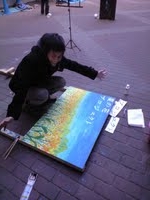Hello, this is Kitazawa of HARU Public Relations.
Thank you all for reading our blog.
This time I would like to share one of the projects of
HARU, Field Mustard Project.
This is the first time sharing this project and it's
about the end of the year, I would like to review the hole activity they have
done. Please stay tuned till the end.
***
The motivator was in July. A professor of agricultural
department contacted us if we wanted to work on Field Mustard Project with him.
We thought we first should see the place, so we participated in slime raking in
July. I could hear from one of the participants:
"We
have raked 1.4 ha paddy with 100 people including students and staffs of Tohoku
University, Japan Red Cross, and NPO Miyagi Disaster Relief Volunteer Center. I
thought there wouldn't be any grass because of brine damage, but there actually
was full of grass."
"However
it seemed like the ecological system was damaged, as we could see only few
kinds were growing there. We felt the necessity of recovery from brine
damage."
"Each
participants shared roles and worked on them in silence. I felt it quite nice
that we could
corroborate with each other, although we were actually first met. However we
could finish only 2/3of what we planed to finish. There were 100 people worked
5 hours. I came up with a question that 'how much percentage we have done today
of the whole affected paddy?'"
"But
at the same time, I thought all the participants felt that we could make
progress even a step or half a step. I thought that we could deliver a warm
light of hope to hearts of who hope reconstruction, which is another
intensional of this Field Mustard Project."
***
As this student have mentioned, even if we
live in Tohoku, there so many things we don't know what's happening at coast
side. Though many projects to help fields are introduced on media, still there
are much much more fields or paddies undone. I didn't realize it until I went
to the place.
After this, HARU have decided to work on
it together. After working on planting and thinning in October, now the field
mustard have grown to here. (They look delicious already!)
Besides, some people who were taking a
walk talked to us looking interested. I realized that those people who live
near here found it put forth buds, and will find swelling of buds and blooming
of fine
yellow first. NOT US!
We are not going to Wakabayashi ward every
day nor have we had much communication with local people. We have worked with
some of them, but that I feel is not enough. So I planed on making a display to
have local people know about us and watch the field mustard together. (We have
just made the base the other day:)
We are planning on placing the display on
the field in a few weeks, after putting our introduction and some other stuff.
Also we are planning on a event or
something to go with blooming and harvesting of the field mustard, involving
local people.
-How about sketching competition?
-Why don't we learn how the field mustards
work for brine damage with local people from professors?
-How can we reduce to local people and
farmers by events?
etc.
That is all for my report on its activity.
P.S. It was my first time going to Wakabayashi ward on
this project.
Green grass was growing in the photo above because it
was summer, in fall I saw many fields covered with tall, light brown grass.
Normally they were having harvest season. That grass wasn't supposed to be
there. I am participating in this for my wish to be any strength to farmers. So
I am willing to hang on to this longer.
Sorry for being this report so long, but thank you for
reading all through.
S.Kitazawa
























